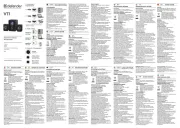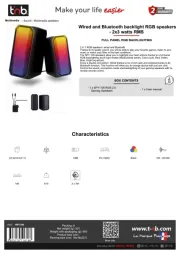DCM TimePiece TP160 Handleiding
Bekijk gratis de handleiding van DCM TimePiece TP160 (10 pagina’s), behorend tot de categorie Speaker. Deze gids werd als nuttig beoordeeld door 14 mensen en kreeg gemiddeld 4.3 sterren uit 7.5 reviews. Heb je een vraag over DCM TimePiece TP160 of wil je andere gebruikers van dit product iets vragen? Stel een vraag
Pagina 1/10

21A8365
1 Mitek Plaza
Winslow, IL 61089
Phone (877)DCM-LOUD
Visit our Internet web site at: www.dcmspeakers.com
DCM is a registered trademark of Mitek Corporation.
Due to our policy of continuous improvement, specifications are subject to change without notice.
Owners Manual
TP160 / TP160C / TP160S
/ TP260 / TP160BDP

INTRODUCTION
Congratulations on your purchase of DCM Timepiece Series Loudspeakers. Your new speakers represent
the latest technologies in loudspeaker design and manufacturing. They will provide outstanding perfor-
mance and years of listening enjoyment. Please take time to read through this manual thoroughly to insure
you get maximum performance out of your new loudspeakers.
FEATURES
• Video shielding for placement near a TV or monitor (except TP160BDP)
• 25mm Teteron® dome tweeter
• Kevlar cone midrange/woofer with phase cap
• Internally braced MDF cabinets
• Chrome 5-way binding posts
• Dark Cherry finish to blend in with any decor
• DCM 10 year limited warranty
SPEAKER PLACEMENT
MAIN LEFT AND RIGHT CHANNELS
TP160S, TP160, TP260
All DCM Loudspeakers have been engineered to combine deep powerful bass with crisp, natural high
frequency performance. Because there are so many factors that affect loudspeaker performance, there is
no universal rule for speaker location. Best results will be obtained with some experimentation using the
following guidelines.
To achieve the most realistic stereo image, position the speakers so that an equilateral triangle is formed
between the speakers and the listening position (Figure 1). Turning the speakers slightly towards the
listening position can improve the image focus.
Bass loudness can be increased by moving the speakers closer to the rear wall. This sometimes can
degrade the stereo image. Use your judgement as to what location best fits your preferences.
SURROUND LEFT AND RIGHT CHANNELS
TP160S
If you are using the TP160S for rear channel speakers in a home theater application, they should be
placed on the side walls and slightly behind the listening position (Figure 1). If this is not practical, they
can be placed on the rear wall to either side of the listening position (Figure 2). For best results, the sur-
round speakers should be spaced equal distances from the listening position with the tweeters at or above
ear level.
CENTER
CHANNEL
LEFT
REAR
RIGHT
REAR
LISTENING AREA
45
LEFT
FRONT
RIGHT
FRONT
RIGHT
FRONT
LEFT
FRONT
CENTER
CHANNEL
LEFT
REAR
RIGHT
REAR
LISTENING AREA
CENTER CHANNEL
TP160C
When using the TP160C as a center channel speaker in a home theater application the following guide-
lines should be used for optimum performance.
Figure 1 - Typical Loudspeaker Placement Figure 2 - Alternate Loudspeaker Placement
NOTES

Locate the speaker as close to the center of your TV or monitor as possible (Figure 3). This will anchor the
central image of your home theater to the location of the images seen on the screen.
Place the center channel at an equal distance to the listening position as the main speakers are. Also,
place the height of the center channel’s tweeter as close to the same height as the main speakers’ tweet-
ers (Figure 3). This will prevent image blurring when sounds are panned form the one side of the room
to the other.
TP160BDP
The TP160BDP speakers are shipped in mirror image pairs. One TP160BDP speaker is the “left” rear
channel speaker, and the other is the “right” rear channel speaker. The label near the input terminal identi-
fies which speaker is which. The “left” surround speaker should be placed on the left side of the room as
you face the front of the room. The TP160BDP speakers feature a high frequency range bipole or dipole
setup, where the tweeters either fire in phase (bipole) or out of phase (dipole). Bipole/Dipole speakers
take advantage of reflected sound to create a wide sound field and they provide greater speaker place-
ment flexibility. For this reason TP160BDP speakers have bipole/dipole switch which lets you choose the
mode in which they operate.
Although the electrical phase in bi-poles and di-poles is different, the basic construction of bi-poles and
di-poles is very similar. A brief description of phase; specifically being in phase and out of phase. In a
general sense, something is in phase if it acts in the same pattern and time session as something else,
and out of phase when it does not. Because controlling the way sound waves interact with each other is
a key component of home theater, it is important to deal with the concept of phase. Bi-pole and di-pole
speakers are designed specifically to help contribute to your surround sound field.
In a Dipolar speaker, the two sets of speakers are out-of-phase with each other, while the drivers on one
side are pushing the opposite side is pulling. The result is that there is a reduced sound zone in the area
along the 90-degree axis of the speaker. When properly set up, a pair of di-pole speakers used as sur-
round speakers will provide very dynamic, enveloping rear effects. This allows you to listen without being
able to pinpoint the location of the speakers themselves. Ideal placement would include positioning the
speakers “in-line” with the preferred listening position. (See Figure 4)
In a Bipolar speaker, the two sets of drivers are in-phase with one another - both sides push air at the
same time. The result is greater sound output than from a di-pole configuration. A bipolar speaker is more
likely to replicate a 360 sound field throughout the room and works well if you need to position your sur-
round speakers behind your listening position. (See Figure 5 and 6)
Ideally, both bi-pole and di-pole speakers work best when mounted on the sides of the listening position
and use reflected sound off of the walls to produce their effects. It is recommend that once you have
Figure 3 - Proper Placement of Center Channel Speaker
NOTES
Product specificaties
| Merk: | DCM |
| Categorie: | Speaker |
| Model: | TimePiece TP160 |
Heb je hulp nodig?
Als je hulp nodig hebt met DCM TimePiece TP160 stel dan hieronder een vraag en andere gebruikers zullen je antwoorden
Handleiding Speaker DCM

12 Augustus 2023

12 Augustus 2023

12 Augustus 2023

12 Augustus 2023

12 Augustus 2023
Handleiding Speaker
- Aperion
- Xcellon
- Titanwolf
- Iluv
- Pulver
- Sven
- DOSS
- Mpman
- Spracht
- Audibax
- Bigben Interactive
- Sonance
- Max
- HK Audio
- Woxter
Nieuwste handleidingen voor Speaker

16 September 2025

16 September 2025

16 September 2025

15 September 2025

15 September 2025

15 September 2025

15 September 2025

15 September 2025

15 September 2025

15 September 2025